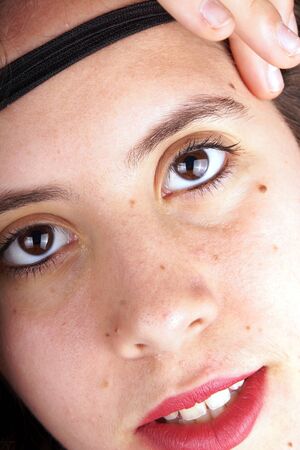Understanding Pigmentation Differences in British Skin Types
The United Kingdom is home to a richly diverse population, with skin types ranging from the fairest porcelain to deep ebony tones. This diversity brings unique challenges and considerations when it comes to skin pigmentation. Uneven skin tone—manifesting as pigmentation, sun spots, and melasma—is influenced by a combination of genetics and environmental factors that are particularly relevant to those living in Britain.
Genetically, individuals inherit their baseline skin colour based on melanin production, which not only determines how the skin looks but also its response to sunlight and other external stressors. People of Northern European descent may be more prone to freckles and lighter pigmentation irregularities, while those from South Asian, African, or Caribbean backgrounds might experience deeper hyperpigmentation or melasma. However, the unpredictable British weather, with its cloudy days punctuated by bursts of intense sunlight, affects everyone’s skin—often catching people off guard during rare sunny spells.
Environmental influences play a significant role as well. UV exposure remains one of the primary drivers of pigmentation issues in the UK, even on overcast days when many assume they are safe from sun damage. Pollution in urban centres like London and Manchester can also contribute to oxidative stress on the skin, exacerbating uneven tone. Additionally, hormonal changes—such as those experienced during pregnancy or due to contraceptive use—are known triggers for melasma across all ethnicities.
Understanding these underlying causes is essential for selecting effective treatments tailored to each individual’s background and lifestyle. In subsequent sections, we will delve into the science behind specific pigmentation conditions common in the UK and explore evidence-based dermatological solutions that suit Britain’s unique climate and cultural context.
2. The Spectrum of Sun Spots in the British Climate
The British climate, often famed for its grey skies and drizzle, might seem unlikely to foster significant pigmentation concerns. However, the interplay of intermittent sunshine, variable cloud cover, and shifting seasons creates a unique environment that influences both the prevalence and nature of sun spots among UK residents. Unlike regions with consistently high UV indices, Britain experiences sporadic bursts of sunlight—often catching individuals off guard during unexpected spells of warm weather. This unpredictability can lead to uneven UV exposure, a key factor in the development of sun-induced pigmentation.
How British Weather Influences Sun Spot Formation
While the overall annual UV index is lower than in many other countries, the cumulative effect of repeated short exposures adds up over time. Britons, perhaps due to the rare appearance of strong sun, may be less diligent with daily sunscreen use, especially outside the summer months. The following table outlines key lifestyle factors impacting sun spot risk in the UK:
| Factor | British Lifestyle Influence | Impact on Sun Spots |
|---|---|---|
| Weather Patterns | Frequent cloud cover; sudden sunny spells | Irregular but intense UV exposure can catch skin unprepared |
| Sunscreen Habits | Often reserved for holidays or peak summer days | Lack of year-round protection increases risk of cumulative damage |
| Outdoor Activities | Spontaneous outings during good weather; gardening and coastal walks popular | Exposure peaks during rare sunny periods, particularly midday |
| Skin Phototypes | Diverse population, but many with fair (Fitzpatrick I-II) skin types | Fairer skin is more susceptible to sun spots and pigmentation changes |
The Localised Nature of Pigmentation Issues in Britain
Melanin production is triggered by UV exposure as a natural defence mechanism. In Britain’s case, this process tends to result in a patchwork pattern—areas like the face, hands, and décolletage are most affected because they are exposed when the weather turns pleasant. Moreover, the sporadic use of hats or protective clothing further amplifies these localised effects.
Cultural Attitudes Towards Sun Exposure
The traditional British attitude towards sunshine has been one of celebration—after all, ‘making the most’ of good weather is practically a national pastime. This cultural tendency means people may underestimate their need for protection during brief periods outdoors, inadvertently increasing their long-term risk for developing sun spots and uneven pigmentation.

3. Melasma: Triggers and Management in the UK Context
Melasma, often characterised by symmetrical brown or greyish patches on the face, is a challenging pigmentary condition that affects people across the UK, particularly those with darker skin tones or of mixed heritage. While melasma is most commonly associated with hormonal changes—such as pregnancy, oral contraceptives, or hormone replacement therapy—its manifestation in the British population is shaped by several localised factors. The unpredictable British weather, with its frequent cloud cover, can be misleading; although the sun may not always be visible, UVA rays are still present and can exacerbate melasma. Furthermore, common medications prescribed in the UK, such as certain anti-epileptic drugs and antibiotics, have been identified as potential triggers for this pigmentation disorder.
Genetics also play a considerable role within families living in Britain, particularly among individuals from South Asian, Afro-Caribbean, or Mediterranean backgrounds. However, it is important to note that anyone may develop melasma given sufficient exposure to risk factors. In addition to hormonal influences and medication, stress—a prevalent issue within urban British environments—can stimulate melanocyte activity via cortisol production, further compounding the problem.
British dermatologists frequently recommend a comprehensive approach to melasma management. Sun protection is non-negotiable; broad-spectrum sunscreen (SPF 30 or higher) should be used daily throughout the year, regardless of cloud coverage. Physical barriers such as hats and sunglasses are also encouraged when outdoors. Topical treatments containing hydroquinone (available on prescription), azelaic acid, or retinoids are commonly prescribed in NHS and private practices. For persistent cases, chemical peels or laser therapies may be considered under specialist supervision.
It is essential for those affected to seek guidance from a qualified dermatologist familiar with managing melasma in diverse skin types and aware of UK-specific environmental factors. Early intervention improves outcomes and helps prevent progression or recurrence of pigmentation issues.
4. Dermatological Treatments Available on the NHS and Privately
When addressing pigmentation, sun spots, and melasma in the UK, individuals typically encounter two main pathways for dermatological care: the National Health Service (NHS) and private clinics. Each route offers different treatment options, waiting times, and levels of personalisation. Understanding these differences is essential for making informed decisions about skin health.
Evidence-Based Medical Treatments
The cornerstone of effective management relies on evidence-based interventions. The following table summarises widely recognised treatments available in British dermatology:
| Treatment | Description | NHS Availability | Private Availability |
|---|---|---|---|
| Topical Hydroquinone | Skin-lightening agent used to reduce hyperpigmentation. Often prescribed for melasma and sun spots. | Rarely, with specialist referral only | Common; tailored formulations available |
| Topical Retinoids (e.g., Tretinoin) | Promote cell turnover and fade pigmentation over time. | Available via prescription, usually for severe cases | Widely available; often combined with other agents |
| Chemical Peels (Superficial) | Mild acids exfoliate upper skin layers to improve tone and texture. | Limited; mostly for medical indications like acne scarring | Common; various strengths and types offered |
| Laser Therapy (e.g., Q-switched lasers) | Targets pigment deposits in the skin with focused light energy. | Rare; considered cosmetic and not routinely provided | Widely available at registered clinics |
| Oral Medications (e.g., Tranexamic Acid) | Used off-label for refractory melasma cases under specialist supervision. | Specialist prescription only; rarely first-line | Available at select dermatology clinics |
| Sunscreen & Sun Protection Advice | Essential component in all treatment plans to prevent worsening pigmentation. | Routine advice given; NHS may provide samples in some cases | Personalised recommendations; premium products sold onsite |
NHS Versus Private Dermatology: Key Differences
NHS Services:
- Treatment is free at the point of use but typically reserved for clinically significant cases (e.g., severe melasma impacting mental health).
- Cosmetic concerns such as mild sun spots are generally not treated by the NHS.
- Longer waiting times and limited access to certain therapies like advanced lasers or bespoke chemical peels.
Private Practice:
- Broader range of treatments, including cosmetic procedures not funded by the NHS.
- Shorter waiting times, more personalised care, and access to cutting-edge technology.
- Treatments can be costly and may require multiple sessions for optimal results.
Cultural Considerations in British Dermatology Practice:
Dermatologists in the UK are mindful of diverse skin types commonly seen across the country. This awareness shapes their approach to selecting safe and effective treatments—particularly important when treating darker skin tones prone to post-inflammatory hyperpigmentation. Both NHS and private clinicians adhere to robust safety guidelines, but private providers often have greater flexibility in tailoring regimens based on individual needs and preferences.
If you are considering treatment for pigmentation issues, it is advisable to consult your GP first for an initial assessment. For those seeking faster access or a broader array of options, reputable private dermatology clinics—registered with the Care Quality Commission—can provide comprehensive solutions aligned with British standards of care.
5. Over-the-Counter British Skincare Solutions
When it comes to managing pigmentation, sun spots, and melasma from the comfort of home, the British high street and chemists offer a broad array of over-the-counter skincare products. Many of these formulations are crafted with ingredients specifically targeted at evening out skin tone and reducing visible signs of hyperpigmentation, making them accessible options for those seeking non-prescription solutions.
Trusted UK Chemist Brands
British consumers often turn to familiar names such as Boots, Superdrug, and Marks & Spencer for their skincare needs. Boots’ own brand, No7, features a range of serums and creams containing clinically-backed ingredients like Vitamin C, which is well-known for its brightening properties. The No7 Laboratories Dark Spot Correcting Booster Serum is frequently reviewed for its gentle yet effective approach to minimising sun-induced pigmentation and age spots.
Key Ingredients to Look For
Effective British over-the-counter solutions commonly include ingredients such as niacinamide (Vitamin B3), azelaic acid, liquorice extract, and alpha arbutin. These actives are praised in user reviews for helping to fade existing pigmentation while preventing new discolouration. The Ordinary’s Niacinamide 10% + Zinc 1%, widely available at UK retailers, is a budget-friendly favourite among those looking to reduce redness and unevenness without irritation.
Popular Product Reviews
User feedback from UK-based online forums and beauty reviewers consistently highlight products like La Roche-Posay Pigmentclar Serum (available in most British chemists) for its lightweight formula and visible improvement in skin clarity. Garnier Ambre Solaire’s SPF ranges are also highly recommended due to the essential role daily sun protection plays in preventing further pigmentation issues—an often-emphasised point by local dermatologists.
Considerations for Sensitive Skin
For those with sensitive skin or rosacea-prone complexions, Simple Kind to Skin Anti-Blemish Moisturiser garners positive mention. Its minimalist ingredient list appeals to those wary of harsh chemicals but still looking for gradual improvements in tone and texture.
A Note on Responsible Use
It is worth noting that while many over-the-counter British skincare products can provide noticeable results, patience is essential—visible changes often require consistent use over several weeks or months. Always patch test new formulations and consult a pharmacist or GP if unsure about potential interactions with existing treatments.
6. Preventative Measures and Sun Safety for British Skin
When it comes to pigmentation issues such as sun spots and melasma, prevention is always better than cure—especially under the unpredictable British skies. While the UK is not renowned for tropical sunshine, UVA and UVB rays can still penetrate clouds and cause cumulative skin damage throughout the year. Adopting practical sun safety habits and making small lifestyle changes are essential steps in maintaining an even skin tone.
Daily Sun Protection: Not Just for Holidays
Many Brits reserve sunscreen for beach holidays abroad, but dermatologists recommend daily application regardless of the weather. Opt for a broad-spectrum SPF 30 or higher, and make it part of your morning routine, much like brushing your teeth. Pay special attention to exposed areas such as the face, neck, ears, and hands—these are often overlooked yet most prone to pigmentation.
Choosing the Right Sunscreen for British Weather
The typical British climate can be damp and overcast, so lightweight, non-greasy formulas that absorb quickly work well. Look for sunscreens labelled non-comedogenic if you are prone to breakouts or have sensitive skin. For those who wear makeup, consider SPF-infused moisturisers or mineral powders as an extra layer of protection.
Protective Clothing and Accessories
Physical barriers can be just as effective as creams. Wide-brimmed hats, sunglasses with UV protection, and long-sleeved clothing offer additional defence against ultraviolet rays. Even during cloudy days or brisk walks across town, these simple adjustments help reduce cumulative sun exposure—a key contributor to uneven pigmentation.
Lifestyle Adjustments for Pigmentation Prevention
Beyond sun protection, certain lifestyle tweaks can further minimise your risk. Avoid using tanning beds entirely; artificial UV exposure is a significant cause of premature skin ageing and hyperpigmentation. If you cycle or commute outdoors regularly, seek shaded routes when possible and reapply sunscreen every two hours, especially during peak daylight from March to October.
Nutritional Considerations
A diet rich in antioxidants supports overall skin health and resilience. Incorporate foods high in vitamins C and E—think berries, nuts, leafy greens—as these nutrients combat free radical damage caused by environmental stressors common in urban British settings.
Cultural Practices: Adapting Habits for Healthier Skin
The British tendency toward outdoor activities—like gardening, football matches, or countryside rambles—means that incidental sun exposure adds up over time. Being mindful of sun safety during these moments is crucial. Make carrying a travel-sized sunscreen as routine as packing an umbrella; this small habit shift can significantly impact your long-term skin health.
In summary, preventing pigmentation problems in Britain requires a proactive mindset: regular use of appropriate sun protection, sensible clothing choices, dietary support, and a conscious adaptation of everyday habits to fit the local climate and culture. These strategies form the foundation for keeping your complexion even-toned and healthy year-round.
7. Real Stories and Advice from British Dermatology Experts
When it comes to tackling pigmentation, sun spots, and melasma, the experiences of real people and expert advice from UK-based dermatologists offer invaluable perspective. Dr. Sarah Williams, a consultant dermatologist in London, notes that “Many of our patients feel frustrated by persistent pigmentation. It’s important for them to know there are effective treatments available, but patience and persistence are key.” She emphasises the importance of tailored regimens and professional assessment for best results.
Patient Perspectives: Navigating Pigmentation Treatment in the UK
Emma, a 42-year-old teacher from Manchester, shares her journey: “I spent years trying over-the-counter creams for my sun spots with little success. It wasn’t until I visited a dermatologist that I learned about prescription retinoids and laser options. The difference has been remarkable, but the process took time and regular follow-up.” Her story echoes many others in Britain who have found that professional guidance makes all the difference.
Tips from British Dermatologists
- Consult Early: Dr. Ahmed Patel, based in Birmingham, recommends seeking professional advice early if you notice persistent dark patches or uneven skin tone that don’t respond to standard skincare products.
- Bespoke Treatment Plans: UK dermatologists often combine topical agents (like hydroquinone or azelaic acid), chemical peels, and light-based therapies tailored to individual skin type and pigmentation pattern.
- Sun Protection Is Non-Negotiable: “Even on cloudy days in Britain, UV exposure can worsen pigmentation,” says Dr. Williams. Broad-spectrum SPF is essential year-round.
Advice on Seeking Help
If you’re struggling with stubborn pigmentation, sun spots, or melasma, consider booking an appointment with a Consultant Dermatologist registered with the General Medical Council (GMC). NHS referrals are possible for severe cases, while private clinics across the UK also offer specialist care. Remember: personalised treatment under expert supervision is often more effective than self-diagnosis or off-the-shelf solutions.
The journey towards an even skin tone may require persistence, but as these British experts and patients demonstrate, effective support is available—right here in the UK’s dermatological community.


